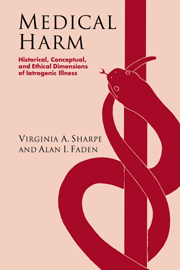5 - Due care as a specification of the duty to ‘do no harm’
Published online by Cambridge University Press: 22 September 2009
Summary
In practice, the obligation to do no harm has traditionally been articulated in the doctrine of ‘due care’; the notion that patients are due or owed a certain standard of care by health care providers. According to Beauchamp and Childress, these requirements follow from the imposition of risk. In the treatment of the patient, standards of due care ‘can be met only if the goals sought justify the risks that must be imposed to achieve the goals’. Historically, the standards governing practice have been determined largely by the medical profession. They have also been mandated by governmental regulation.
In recent years, third-party payers attempting to get more value for their health care expenditures, have begun to place greater emphasis on knowing what works, using what works, and doing well what works in the delivery of care. In so doing, these economic agents have emerged as a new and powerful source of standards oriented not only to the quality of medical and nursing care but also to its cost. As more explicit attention is given to quality and cost in health care, we will need to determine whether and to what degree new efforts at standardization are coincident not simply with greater efficiency and economy but, more importantly, with the duty to do no harm. In this chapter, we argue that the shift to more evidence-based standards in medicine is a promising one to the extent that it is guided primarily by moral, rather than financial considerations.
- Type
- Chapter
- Information
- Medical HarmHistorical, Conceptual and Ethical Dimensions of Iatrogenic Illness, pp. 100 - 114Publisher: Cambridge University PressPrint publication year: 1998



